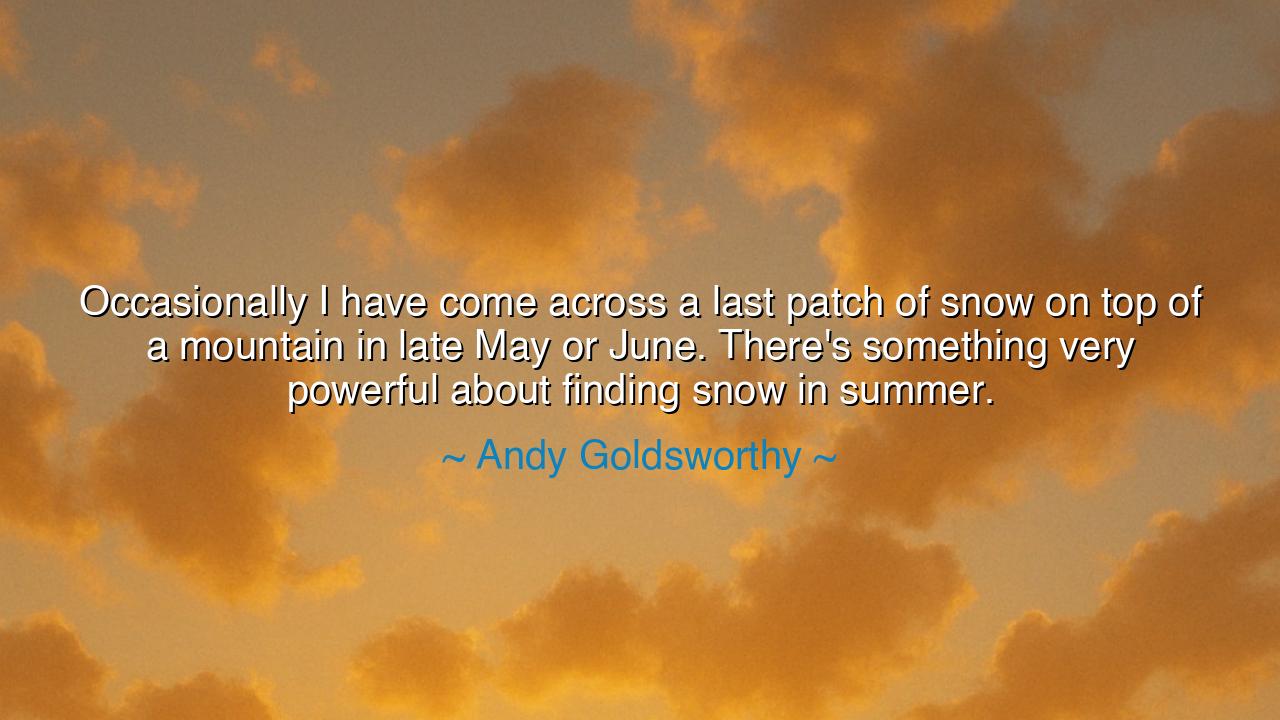
Occasionally I have come across a last patch of snow on top of a
Occasionally I have come across a last patch of snow on top of a mountain in late May or June. There's something very powerful about finding snow in summer.






Andy Goldsworthy once reflected: “Occasionally I have come across a last patch of snow on top of a mountain in late May or June. There’s something very powerful about finding snow in summer.” These words are not only about nature, but about life itself. They speak to the wonder of encountering the unexpected, the beauty of contrast, and the strength of what endures beyond its season. For snow in summer is a reminder that what seems gone is not always lost, and that even in the warmth of life’s ease, the memory of struggle and endurance may still remain.
The origin of this reflection lies in Goldsworthy’s deep connection with the natural world. As an artist who shaped leaves, stones, ice, and earth into fleeting works, he was ever attentive to what the seasons revealed. To him, snow was not merely frozen water, but a presence—fragile, temporary, yet strong enough to outlast the sun when nestled in the high places. To stumble upon it in summer is to be humbled, for it whispers of winter’s trials even when the fields below bloom with flowers. It is both a reminder of impermanence and of endurance.
The ancients, too, found meaning in contrasts. Heraclitus taught that life is shaped by opposites—day and night, war and peace, hunger and satiety. The snow in summer embodies this teaching: cold persisting in warmth, silence resting within abundance. It shows that within every season, traces of the last remain. Just as joy carries the memory of sorrow, and wisdom carries the lessons of folly, so too does summer carry the ghost of winter, preserved upon the mountain’s crown.
History gives us many parallels. Think of Hannibal, crossing the Alps with his army. Amid the cold of the mountains, his men dreamed of warmer lands beyond. Yet the very snow they despised in hardship became their companion, testing their resolve and tempering their strength. Later, when they descended into the plains of Italy, the memory of the mountains stayed within them, giving edge to their courage. So too does Goldsworthy’s patch of snow remind us that endurance through hardship leaves traces that strengthen us even in gentler times.
The meaning of the quote is profound: it teaches that the past never wholly disappears. The trials we endure—our winters—leave within us remnants, scars, and strengths that remain even when life becomes easier. These remnants are like the snow in summer: at once out of place and yet deeply powerful, a hidden reservoir of memory and resilience. To encounter them is to remember who we are, what we have survived, and what continues to live in us.
The lesson for us is this: cherish the contrasts of life. When you find yourself in a season of warmth, do not despise the reminders of cold that remain. Instead, honor them, for they give depth to your joy and weight to your peace. Just as the snow high on the mountain does not melt away at once, so too the lessons of hardship do not vanish when easier times arrive. Let them stay within you, shaping you into one who can endure both the storm and the sun.
In practice, this means walking with gratitude for both your winters and your summers. Do not rush to forget the hardships you have endured, for they are the roots of your strength. When reminders of those struggles surface—like the snow in summer—pause, reflect, and draw power from them. They are not remnants to discard, but treasures to keep. In every season, allow the memory of contrast to guide you, for it is in balance that wisdom is found.
Therefore, remember Andy Goldsworthy’s words: “There’s something very powerful about finding snow in summer.” For in that image lies the truth of life: that the past shapes the present, that contrasts give beauty to existence, and that endurance makes joy all the sweeter. Embrace both the snow and the sun, the hardship and the ease, and you will walk as one rooted in the fullness of life’s eternal rhythm.






AAdministratorAdministrator
Welcome, honored guests. Please leave a comment, we will respond soon